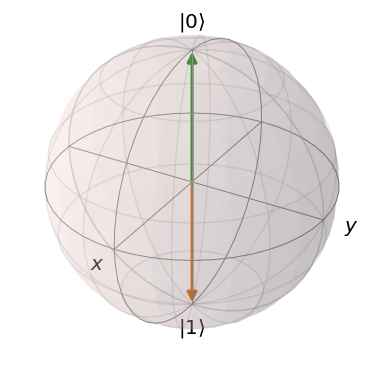Bloch Sphere¶
\[% https://latex.wikia.org/wiki/List_of_LaTeX_symbols
% https://www.overleaf.com/learn/latex/Main_Page
%
% latex commands for quantum mechanics: bra & kets
\newcommand{\bra}[1]{\left<#1\right|}
\newcommand{\ket}[1]{\left|#1\right>}
\newcommand{\bk}[2]{\left<#1\middle|#2\right>}
\newcommand{\bke}[3]{\left<#1\middle|#2\middle|#3\right>}
%
% general shortcuts
\newcommand{\bm}[1]{\boldsymbol{#1}} % bold math
\newcommand{\super}[2]{#1 {}^{#2}} % superscript
\newcommand{\half}{\frac{1}{2}}
%
% hats together with subscripts or superscript (e.g. for angular momentum)
\newcommand{\hatb}[1]{\bm{\hat{#1}}} % hat + bold
\newcommand{\hatsub}[2]{\hat{{#1}_{#2}}} % hat + subscript
\newcommand{\hatsup}[2]{\super{\hat{#1}}{#2}} % hat + superscript
\newcommand{\hatsubsup}[3]{\super{\hat{#1}}{#3}_{#2}} % hat + sub + superscript
%
% Pauli operators
\newcommand{\pauliX}{\hatsubsup{\sigma}{X}{}}
\newcommand{\pauliY}{\hatsubsup{\sigma}{Y}{}}
\newcommand{\pauliZ}{\hatsubsup{\sigma}{Z}{}}
\newcommand{\pauliP}{\hatsubsup{\sigma}{+}{}}
\newcommand{\pauliM}{\hatsubsup{\sigma}{-}{}}
\newcommand{\pauliPM}{\hatsubsup{\sigma}{\pm}{}}
%
% derivates
\newcommand{\odv}[2]{\frac{\textrm{d} #1}{\textrm{d} #2}}
\newcommand{\pdv}[2]{\frac{\partial #1}{\partial #2}}\]
The Bloch sphere is used to represent the state of two-level systems.
It is, in fact, the visualization of vectors of a complex Hilbert space of dimension 2 (\(\mathbb C^2\) space), in contrast to real spaces, that we are familiar with and easy to interpret.
The two vectors \(\ket{0}\) and \(\ket{1}\) of a chosen basis are represented on the z-axis.

While the x- and y-axis represent the following superpositions of the basis vectors:
x-axis: \(\ket{0} \pm \ket{1}\)
y-axis: \(\ket{0} \pm i \ket{1}\)
Complements